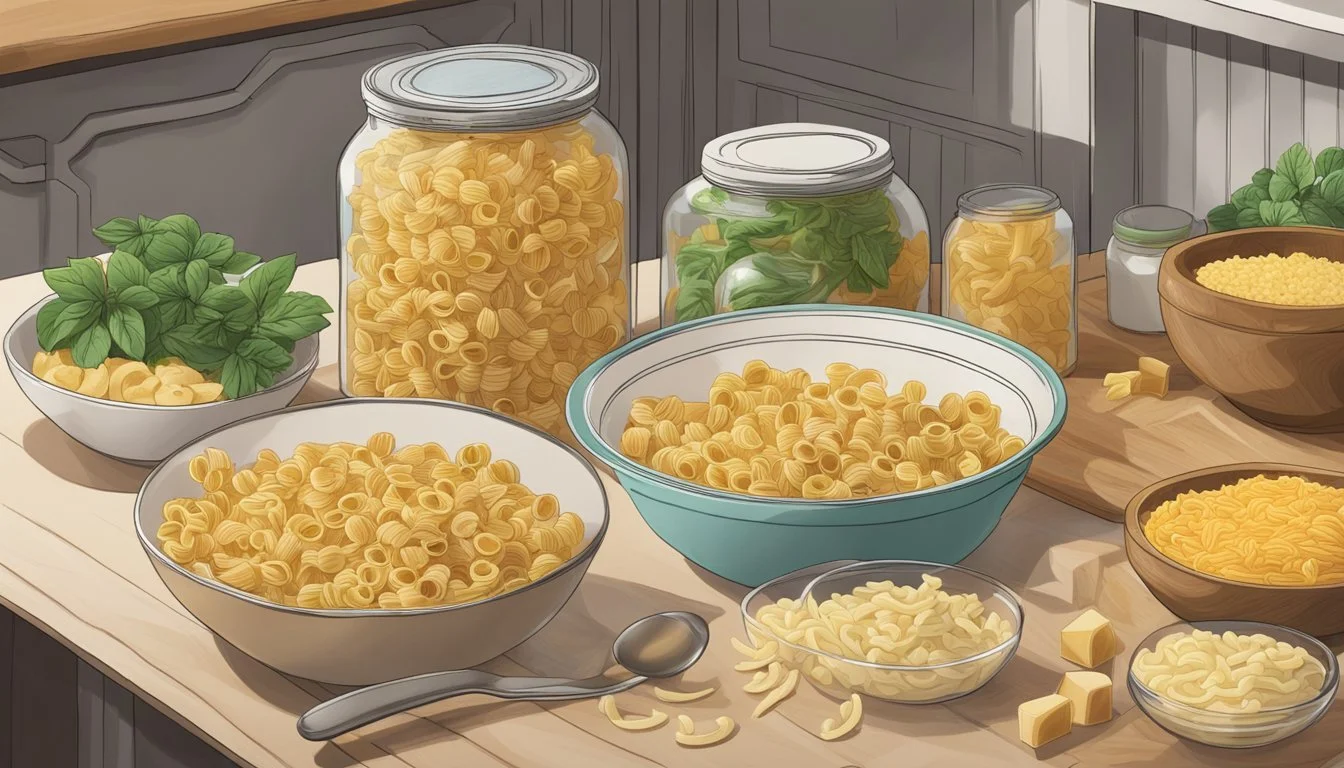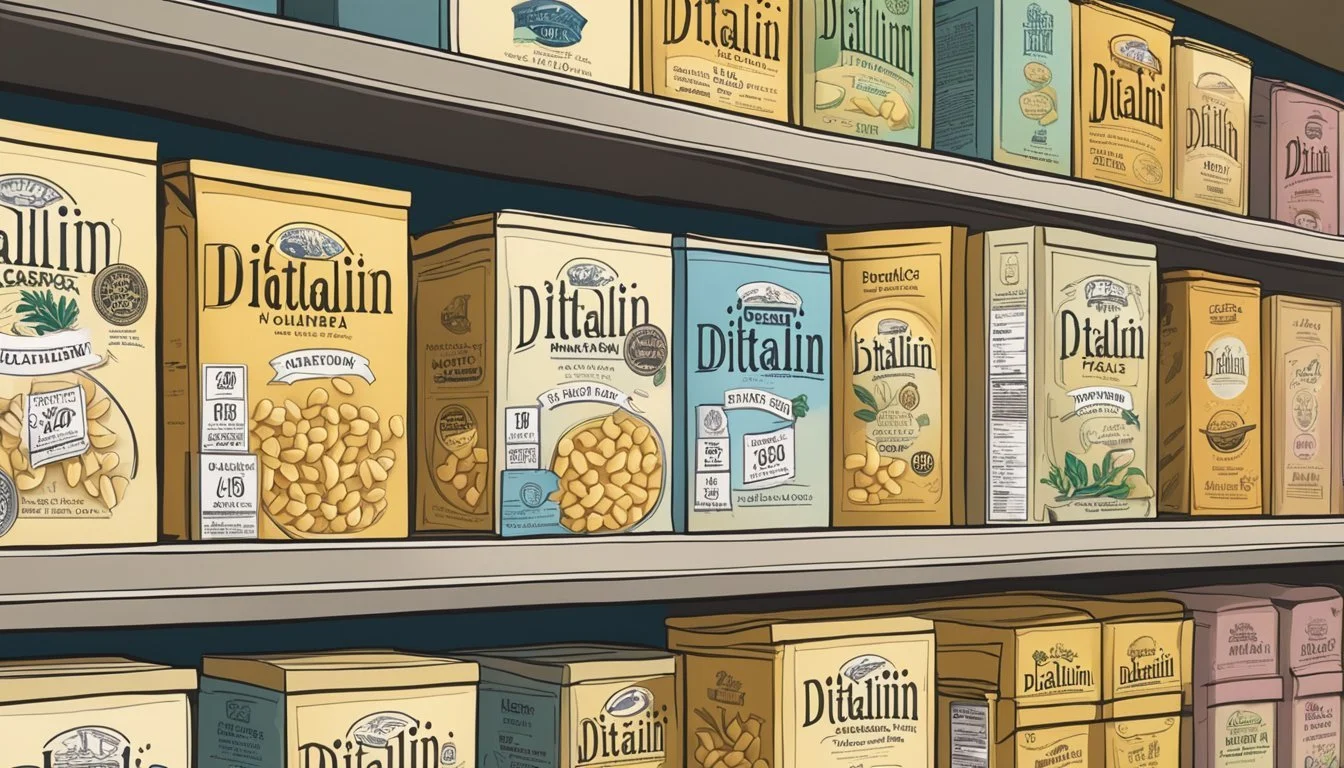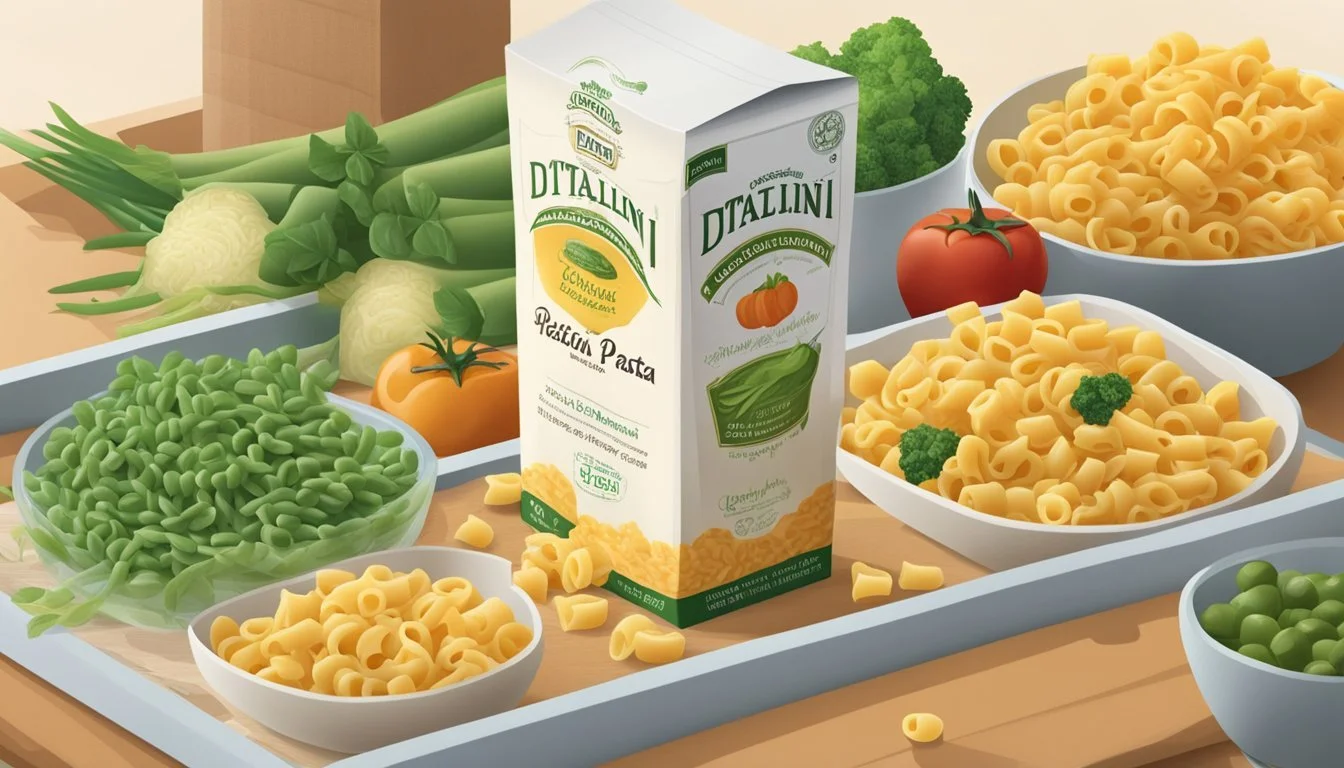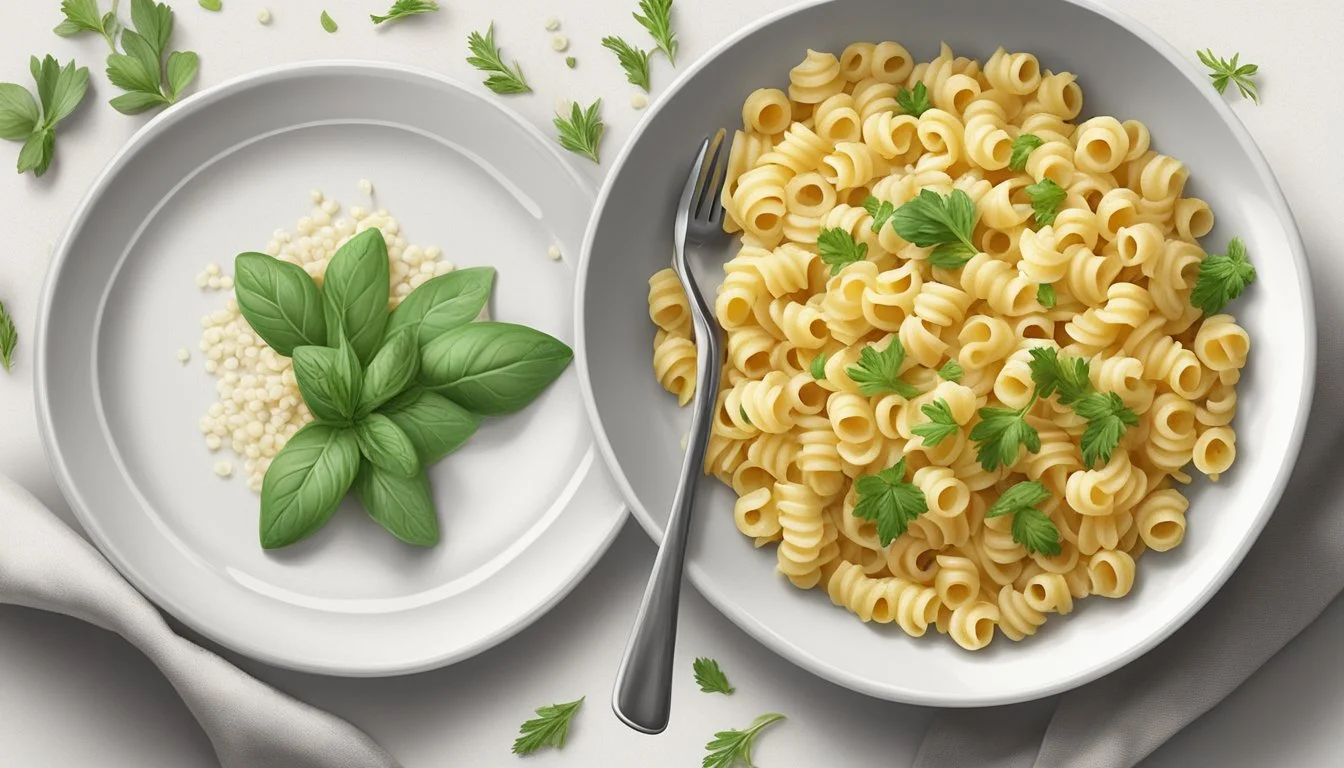How Long Does Ditalini Pasta Last?
Shelf Life and Storage Tips
Ditalini pasta (What wine goes well with pasta?), known for its small, tube-like shape, is a versatile ingredient often used in soups and salads. Like other dry pastas, ditalini is made from semolina flour (how long does semolina flour last?) and water, ingredients that confer a long shelf life when the pasta is stored properly. It's a product that can keep in a cool, dry place, such as a pantry or cupboard, for quite some time without losing its quality.
Uncooked ditalini pasta generally has a shelf life that can extend to several years past the printed expiration date, although it is recommended to use within about two years for optimum flavor and texture. Once the package is opened, it should be sealed in an airtight container to preserve its freshness. Keeping it away from moisture and heat sources will help prevent it from going stale.
When cooked, ditalini pasta behaves like most pasta varieties; it can last in the refrigerator for up to five days when stored in an airtight container. For longer storage, cooked ditalini can be frozen and is best used within two months. This ensures that the pasta maintains its taste and firmness when reheated.
Pasta Fundamentals
In tackling the key aspects of pasta, it's essential to understand the distinctive traits of ditalini pasta, its cooking methods, and the fundamental ingredients that complement its preparation perfectly.
Ditalini Pasta Characteristics
Ditalini, meaning "little thimbles," is a small, tube-shaped pasta that excels in various dishes due to its bite-size and versatile nature. Measuring just a few millimeters in diameter and length, these pasta tubes are ideally suited for soups and stews where they complement both the texture and the broth's flavor. The pasta's diminutive size allows it to cook quickly and absorb sauces effectively, making it a favorite for a busy cook seeking efficiency without sacrificing taste.
Cooking Techniques
Proper cooking is essential for ditalini to maintain its characteristically pleasing texture. To cook ditalini pasta al dente, or "to the tooth," one must boil it in salted water for approximately 8 to 10 minutes. The salt enhances the flavor, and the boiling water must remain at a consistent rolling boil to ensure even cooking. Stirring occasionally prevents sticking and ensures each tube cooks uniformly. Testing the pasta's texture a minute or two before the recommended cooking time can help achieve that perfect al dente bite.
Essential Ingredients
When preparing ditalini pasta, the choice of ingredients can elevate the dish to its fullest potential. For a basic yet splendid pasta, one may use:
Olive oil or butter: To add richness.
Cheese: Parmesan or pecorino for a salty, umami kick.
Vegetables: Such as peas or spinach, for added nutrition and color.
Meat or alternatives: To create a more hearty meal. For vegans or vegetarians, chickpeas or lentils (how long do lentils last?) can be an excellent protein-packed addition.
Whether one chooses to dress the pasta simply with butter and cheese or enrich it with a variety of vegetables and proteins, ditalini's capacity to adapt to different ingredients makes it an indispensable staple in the kitchen.
Preparing Ditalini Pasta
Preparing Ditalini Pasta involves boiling the pasta to perfection, incorporating it into various dishes, and seasoning it for enhanced flavor. The process is straightforward if done with attention to detail.
Boiling Ditalini
For boiling ditalini pasta, one should use a large pot, filling it with 4-6 quarts of water per pound of pasta. This ensures enough space for even cooking and prevents sticking. The steps are:
Bring the pot of water to a rolling boil.
Add a generous pinch of sea salt (how long does sea salt last?) to the water to enhance the pasta’s flavor.
Introduce the ditalini to the boiling water and stir occasionally.
Boil for 8-10 minutes or until al dente, which means the pasta should be firm to the bite.
Creating Dishes
Ditalini pasta is versatile; after boiling, it is a prime candidate for various dishes:
Soups: Like minestrone or pasta e fagioli, where the small pasta size adds texture without overwhelming the soup.
Salads: It is excellent for pasta salads, offering neat, bite-sized pieces that absorb dressings well.
Casseroles: Delightful in baked dishes as it holds its shape and pairs well with creamy sauces (What wine goes well with creamy sauces?).
Macaroni and Cheese: Can be used instead of traditional macaroni for a fun twist on the classic.
Seasoning and Flavoring
When it comes to seasoning ditalini pasta, a mix of herbs and cheese often works best to complement its texture. Common additions include:
Herbs: Oregano, basil, thyme — finely chopped and mixed in for freshness.
Cheese: Parmesan cheese grated over hot pasta to melt slightly and add a salty, nutty flavor.
Vegetables: Peas or finely diced vegetables can be mixed in for nutrition and color.
Black pepper: A sprinkle of black pepper for a final flavor boost.
Incorporating these elements while the pasta is still warm ensures optimal flavor absorption.
Pasta Pairings and Uses
Ditalini, a small tubular pasta, excels in its adaptability with various ingredients and is featured prominently in dishes that range from comforting soups to lush pasta salads. Here, we will explore the ingredients that complement ditalini, the diverse recipes it stars in, and suitable substitutions.
Complementary Ingredients
Beans and Peas: Ditalini pairs excellently with legumes like cannellini beans (how long do cannellini beans last?) and sweet peas, serving as the backbone in Pasta e Fagioli and similar hearty soups.
Cheese: A variety of cheeses, from creamy to hard, like Parmesan or pecorino, bolster the flavor and texture of ditalini-based dishes.
Vegetables: Vegetables such as spinach add nutritional value and color contrast, making for visually appealing and balanced dishes.
Meat: Ground lamb or beef can transform a simple pasta dish into a more substantial meal, often browned and seasoned for added depth.
Olive Oil and Cream: These help to create silky sauces that coat the ditalini perfectly, for either light, zesty dressings or richer, indulgent experiences.
Versatile Recipes
Minestrone: A classic Italian soup featuring ditalini, enriched with vegetables, beans, and often meat.
Pasta Salad Recipes: Cold pasta salads with ditalini allow for creativity, incorporating dairy such as feta or mozzarella, along with a variety of vegetables and dressings.
Cheesy Ditalini with Mixed Greens: Combining the pasta with leafy greens and a variety of melted cheeses results in a comforting dish suitable for any meal.
Substitutions
Penne or Rotini: For those who prefer a different texture or are looking to make a dish heartier, these pastas can serve as good substitutes for ditalini.
Orzo: (how long does orzo last?) This rice-shaped pasta is an excellent alternative for salads and soups when ditalini is unavailable.
Gluten-Free Options: Gluten-sensitive individuals can opt for gluten-free alternatives made from rice, quinoa, or corn to enjoy similar dishes without dietary concerns.
Storage and Shelf Life
Determining the proper storage methods and understanding shelf life duration is crucial for maintaining the quality of ditalini pasta.
Proper Storage Practices
To maximize the longevity of ditalini pasta, one must store the product in an airtight container. This storage method is essential to prevent exposure to moisture and other contaminants. In the refrigerator, cooked pasta should be stored in an airtight container to maintain its freshness and prevent it from absorbing other odors.
For uncooked pasta, the original packaging suffices if it is unopened and undamaged; otherwise, transferring the pasta to an airtight container is advisable. The freezer is not recommended for uncooked pasta, but it is an option for prolonging the shelf life of cooked pasta if necessary.
Shelf Life Duration
Dried pasta: Typically, dried ditalini pasta has a shelf life of approximately 1 to 2 years beyond its "best by" date when stored properly in a pantry. If the pasta is stored in an airtight container and kept in a cool, dry place, its lifespan can be extended.
State of Pasta Recommended Shelf Life Uncooked, original packaging 1-2 years past "best by" date Uncooked, airtight container Can extend beyond 2 years Cooked, refrigerator 4-5 days
Cooked pasta: When cooked, ditalini pasta should be refrigerated in an airtight container and is typically safe to consume within 4 to 5 days. If one wishes to keep cooked pasta longer, it can be frozen and stored for approximately 2 months. However, the quality may be affected upon thawing and reheating.
Health and Dietary Considerations
When considering ditalini pasta for personal consumption or for serving to others, it is important to review nutritional information and understand how it fits within various dietary preferences.
Nutritional Information
Ditalini pasta is traditionally made from wheat, and thus it provides a significant amount of energy. A typical serving size of classic ditalini pasta contains approximately:
Calories: 200
Protein: 7g
Given that it is often enriched, ditalini pasta also contributes to daily vitamin and mineral intake offering nutrients such as iron and several B vitamins, including niacin, thiamine mononitrate, riboflavin, and folic acid. For those opting for whole wheat variations, expect higher levels of fiber and slightly altered caloric and macronutrient profiles.
Dietary Preferences
The versatility of ditalini pasta extends to its compatibility with various dietary considerations:
Vegetarian: It is suitable for vegetarians as it does not contain animal-derived ingredients.
Vegan: Standard ditalini pasta without eggs or dairy additives is also vegan-friendly.
Gluten-Free: There are gluten-free options available made from lentil-, bean-, or pea-based materials for those with gluten sensitivities or celiac disease.
Dairy-Free: Generally, pasta does not contain dairy, making it a fitting choice for individuals with lactose intolerance or dairy allergies.
Individuals should always check packaging for specific dietary labels to ensure that the pasta meets their personal health requirements and dietary restrictions.
Serving and Presentation
When serving ditalini pasta, chefs prioritize flavor enhancement and visual appeal. Proper presentation of the pasta not only complements the dish but also elevates the dining experience.
Serving Suggestions
Ditalini pasta is versatile and can be served in a variety of ways. It integrates well in soups and salads, or as a complement to a main dish. To serve ditalini pasta:
Hot: Pair it with robust sauces that cling to the small tubes, or incorporate it into hearty soups like Italian minestrone.
Cold: Serve chilled in pasta salads, dressed with a light vinaigrette to maintain its texture and flavor.
For added flavor, a garnish of freshly grated Parmesan cheese and a sprinkle of chopped basil can enhance the taste and aroma of the pasta.
Presentation Tips
Presentation is key to entice the palate. When plating ditalini pasta:
Opt for shallow bowls or plates to showcase the pasta's shape.
Drizzle with high-quality olive oil for a glossy finish.
Set colorful and bright ingredients like cherry tomatoes or spinach on top for a visually appealing contrast.
By combining these elements, one can present ditalini pasta in a way that is both appetizing and aesthetically pleasing.
Ditalini Pasta in Social Events
Ditalini pasta, with its small, tube-like shape, is a versatile ingredient that can be incorporated into numerous dishes suitable for a wide range of social events. Its adaptability allows it to be served in both relaxed and elegant settings, providing comfort and satisfying guests' appetites across seasons.
Casual and Formal Gatherings
When it comes to casual gatherings like picnics and potlucks, ditalini pasta is a great addition. It's small enough to mix well in pasta salads and can hold its own among other picnic staples. Not only does it fare well in cold dishes, but it also works as a base in casseroles and baked dishes that often become the centerpiece at potlucks.
On the other hand, ditalini pasta transitions effortlessly to formal events as well. Its refined appearance makes it an ideal choice for sophisticated soups and side dishes that can be served at formal dinners. Whether featured in a light broth or part of a richer, cream-based soup, ditalini noodles enhance the dining experience without overwhelming other flavors.
Comfort Dishes
The very essence of comfort food is often found in the simplicity and heartiness of the dish. Ditalini noodles, due to their small size and starchy goodness, are perfect for nostalgic comfort dishes that warm the soul. They are frequently found swimming in hearty, vegetable-laden Minestrone soup or paired with beans in the classic Italian Pasta e Fagioli.
These soups and stews featuring ditalini are staples at gatherings where warmth and satiety are essential. Their ability to absorb flavors makes them optimal for slowly simmered casseroles too.
Seasonal Favorites
With each season comes a fresh way to enjoy ditalini pasta. In the warmer months, it's a popular choice for pasta salads, served chilled with a fresh vinaigrette, ripe tomatoes, cucumbers, and other seasonal vegetables.
As the weather cools, ditalini pasta becomes the star of hot soups and baked dishes. During autumn and winter gatherings, a bowl of steamy minestrone soup with ditalini is not only seasonal but also a comforting option that pleases a crowd. No matter the time of year, ditalini pasta adapts to seasonal ingredients and traditional recipes, making it a perennial favorite for events and get-togethers.
Frequently Asked Questions
In this section, readers will find detailed answers regarding the preparation, longevity, and nutritional aspects of ditalini pasta, helping them to make well-informed decisions in cooking and storing this pasta variety.
Cooking and Preparation Queries
When cooking ditalini pasta, al dente is the texture most chefs aim for. To achieve this, ditalini usually requires 10 to 11 minutes of boiling in water. It's critical to use a large pot, ideally with 4-6 quarts of water per pound of pasta, bringing the water to a rolling boil before adding the pasta to prevent sticking. Adding salt to the water can enhance the pasta's flavor and offers a better surface for sauce adherence.
Storage and Shelf Life Inquiries
Ditalini pasta should be stored in an airtight container and placed in a cool, dry environment to maximize its shelf life. Uncooked ditalini can last for several months when correctly stored. Once cooked, it should be refrigerated and is typically best when consumed within 3 to 5 days. The refrigerator extends its freshness, but always ensure the pasta is cooled before storing to avoid condensation which could make it sticky or prematurely spoil.
Health and Nutrition Concerns
A single serving of ditalini pasta generally contains about 200 calories, and most brands offer this information readily on the packaging. For those seeking alternative dietary options, whole wheat ditalini offers more fiber, and gluten-free options are available for those with gluten intolerances. Always check the packaging for specific health and nutrition information.










